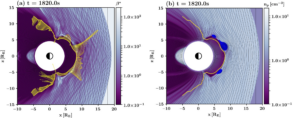The Magnetosheath Transport: From Local Kinetics to Global Dynamics (MAST) project quantitatively assessed the solar wind–magnetosphere–ionosphere (SW-M-I) energetics including effects of solar wind and magnetosheath fluctuations to resolve the energy dissipation processes and paths under a variety of solar wind and IMF conditions. Specifically, we seeked to understand the solar wind energy entry processes through the magnetopause, and the effects of solar wind and/or magnetosheath fluctuations on these processes.
The research employed three global magnetospheric simulation setups employing two versions of the Space Weather Modeling Framework (SWMF) Geospace model (Brenner et al., and the Vlasiator global Vlasov simulation (collaboration with University of Helsinki, Ala-Lahti et al. 2022, Palmroth et al., 2023).
We compared the model results with in-situ measurements using THEMIS, Van Allen Probes, MMS, Cluster, and other available spacecraft as well as with geomagnetic indices AU/AL and SYM-H, or their equivalents using additional stations provided by the SuperMAG network. We compared the energy dissipation in the ionosphere and in the inner magnetosphere using observational proxies based on the geomagnetic indices (Pulkkinen et al., 2022, Al Shidi et al., 2022).
The figure below shows the energy flux through the magnetopause boundary (yellow arrows) showing the simultaneous energy inflow and outflow at any given time. Figure credit: Ala-Lahti et al., 2022.

